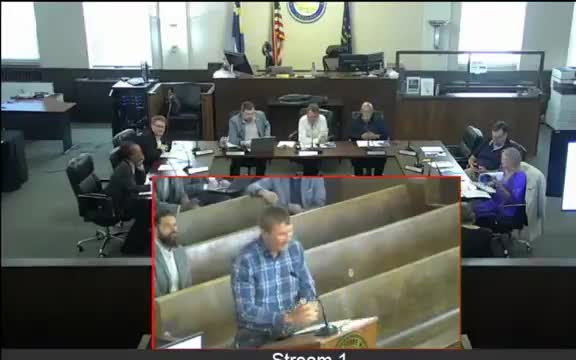Terre Haute explains IDEM-approved 25-year long-term control plan for combined sewer overflows
October 10, 2025 | Terre Haute City, Vigo County, Indiana
This article was created by AI summarizing key points discussed. AI makes mistakes, so for full details and context, please refer to the video of the full meeting. Please report any errors so we can fix them. Report an error »

City engineering staff told the Terre Haute City Council on Oct. 9 that the city’s long-term control plan for combined sewer overflows (CSOs) has been approved under an integrated-planning approach, giving the city 25 years from the approval date to meet its control goals.
Marcus Marr of the engineering department said the city reviewed multiple alternatives—including roughly 20 subalternatives across five primary options—before settling on a revised plan whose estimated cost was about $290,000,000. He said that when staff reran the older 2011 plan through current cost estimates, that plan’s estimated cost rose to about $320,000,000.
Marr said the integrated-planning approach, now accepted by IDEM (Indiana Department of Environmental Management), allows the city to combine long-term CSO work with other stormwater and sanitary projects so work to maintain or improve existing infrastructure can be considered alongside CSO controls. He told the council that the approved plan targets an average of about seven overflows per year in a typical year (the presentation used 1977 rainfall as the “typical year” benchmark) and uses a combination of a new parallel interceptor (designed as a tunneled 78-inch pipe in place of an earlier 12-foot diameter concept), localized storage and floatables control at the Walnut Street outfall to limit debris.
Marr described the city’s main interceptor along the Wabash River, noting large diameter older sewers that feed into a 66-inch pipe leading to CSOs, and said new tunneling and localized storage helped lower the overall estimate. He said the plan provides a longer compliance window and additional flexibility for capital planning.
Mayor Sackman summarized the effect for residents: the integrated plan stretches the timeline so rate increases and project costs can be spread over 25 years rather than a shorter schedule, and the city’s cost cap tied to federal expectations is generally measured as roughly 2% of median household income. He said the administration would use the longer timeline to pursue funding and sequence projects to reduce immediate rate impacts.
Marr and the mayor answered council questions but no formal council vote on the plan was recorded at the meeting.
Marcus Marr of the engineering department said the city reviewed multiple alternatives—including roughly 20 subalternatives across five primary options—before settling on a revised plan whose estimated cost was about $290,000,000. He said that when staff reran the older 2011 plan through current cost estimates, that plan’s estimated cost rose to about $320,000,000.
Marr said the integrated-planning approach, now accepted by IDEM (Indiana Department of Environmental Management), allows the city to combine long-term CSO work with other stormwater and sanitary projects so work to maintain or improve existing infrastructure can be considered alongside CSO controls. He told the council that the approved plan targets an average of about seven overflows per year in a typical year (the presentation used 1977 rainfall as the “typical year” benchmark) and uses a combination of a new parallel interceptor (designed as a tunneled 78-inch pipe in place of an earlier 12-foot diameter concept), localized storage and floatables control at the Walnut Street outfall to limit debris.
Marr described the city’s main interceptor along the Wabash River, noting large diameter older sewers that feed into a 66-inch pipe leading to CSOs, and said new tunneling and localized storage helped lower the overall estimate. He said the plan provides a longer compliance window and additional flexibility for capital planning.
Mayor Sackman summarized the effect for residents: the integrated plan stretches the timeline so rate increases and project costs can be spread over 25 years rather than a shorter schedule, and the city’s cost cap tied to federal expectations is generally measured as roughly 2% of median household income. He said the administration would use the longer timeline to pursue funding and sequence projects to reduce immediate rate impacts.
Marr and the mayor answered council questions but no formal council vote on the plan was recorded at the meeting.
View full meeting
This article is based on a recent meeting—watch the full video and explore the complete transcript for deeper insights into the discussion.
View full meeting
